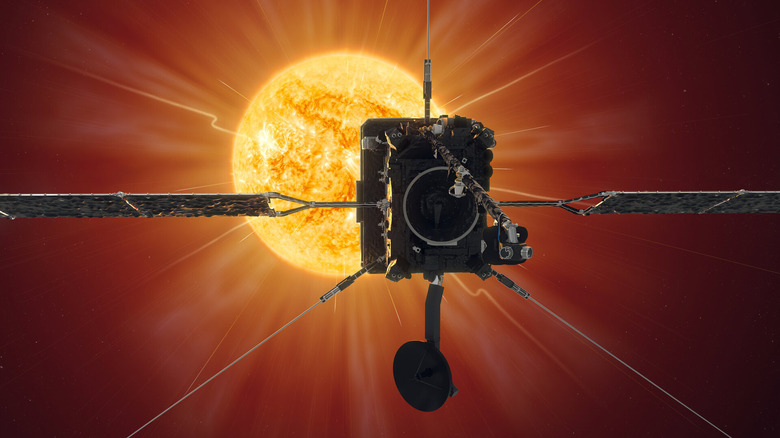Solar Orbiter Is Hitting A Special Milestone On Its Journey To The Sun
The journey for a spacecraft to reach the sun is a long one. You can't just launch a spacecraft from Earth straight toward the sun – instead you have to send it into orbit around the sun, and gradually bring it closer in over time by using gravity assists from planets. That's what the Solar Orbiter, a mission from the European Space Agency (ESA) and NASA, is doing right now. Launched in 2020, it is gearing up to make its next close approach to the sun and today, March 7 2022, it is passing a special point.
The spacecraft is crossing a line called the Earth-Sun line today, which means it is in exact alignment between the Earth and the sun at around half of the distance between them (via ESA). As well as being a neat milestone, this also offers the opportunity for the spacecraft to do some exciting science.
Solar Orbiter is studying space weather, which is a phenomenon caused by the sun sending out streams of particles called solar winds. Even across the vast distances of the solar system, these particles travel outward and affect the environment, especially when they interact with Earth's atmosphere. It's important to study space weather as it can affect both astronauts who are outside the Earth's protective magnetosphere, and the electronics on satellites.
But it's difficult to study space weather because the cause of it – the sun – is located so far away from where its effects are observed here on Earth. That's where Solar Orbiter comes in.
Studying space weather
Solar Orbiter will take observations of the sun as it passes the Earth-Sun line, and these will be compared with readings from other missions which are closer to Earth, like the Hinode and IRIS spacecraft or ESA's Solar and Heliospheric Observatory (SOHO). This way, researchers will be able to see a direct line between what is happening near the sun, and how this is affecting the space weather nearer Earth.
Currently, Solar Orbiter is 47 million miles or 75 million kilometers from the sun, which is around the same distance from the sun that it came during its first close pass in June 2020. But it is going to get closer after it passes the orbit of Mercury on 14 March, and will make its closest approach yet on 26 March. Then it will be within one third of the distance between the Sun and the Earth. "From this point onwards, we are 'entering the unknown' as far as Solar Orbiter's observations of the Sun are concerned," said Daniel Müller, Solar Orbiter Project Scientist (via ESA).
Getting this close will allow more close observations of the sun, such as looking into the strange 'campfires' that the mission detected on the sun's surface in 2021.
"What I'm most looking forward to is finding out whether all these dynamical features we see in the Extreme Ultraviolet Imager (coined campfires) can make their way into the solar wind or not," said Louise Harra, co-Principal Investigator for one of Solar Orbiter's instruments. "There are so many of them!"
